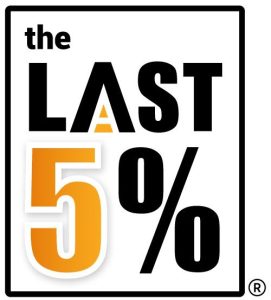
Photo above: RAM Pavement, a Charlotte-based paving company renews at least one truck in its fleet with a brand-new vehicle approximately every three years. With each new truck purchase, an older vehicle is passed down to a less senior employee.
By: Jeff Heybruck
“We’re reimbursing our employees for mileage and it’s getting more and more expensive, should we get our employees company cars instead?” Our clients have posed this question to our team of CFOs and Accountants many times. When it comes to cars driven by employees, businesses have two options:
- Provide company-owned vehicles (We’ll dive into 2 company fleet use cases that took very different approaches – both successfully – later in this article.)
- Let employees use their own cars and directly reimburse them for mileage (And we do mean reimbursement. Giving a credit to employees beforehand and saying it’s for their car and mileage is taxable, so make sure the process is a true reimbursement.)
Before getting carried away with a gut reaction to rising mileage reimbursement costs, we advise our clients to perform an apples-to-apples monthly cost comparison of mileage reimbursement vs. using company-owned vehicles.
The exact mileage at which it becomes more cost-effective to provide a company-owned vehicle rather than reimburse an employee for mileage depends on several factors. Fuel costs, vehicle maintenance costs, typical miles driven per month and the mileage reimbursement rate (the 2024 standard rate is 67 cents per mile) all come into play. This will take a little bit of research so that assumptions can be plugged into the formula, but it’s worth it to make the decision with real data points at hand.
To calculate the break-even mileage point, use the following formula:
Example:
If the all-in monthly cost of a company-owned vehicle is $700 (insurance + taxes + lease payment + gas + maintenance/car washes, etc.), and the reimbursement rate is $0.67 per mile, the monthly mileage break-even point would be:
Monthly mileage = $700 / $0.67/mile = 1,044 miles
Per the above formula, monthly miles driven will sometimes tip the scale in favor of company-owned cars. Tip: Make sure that the miles calculated are for business purposes, not commuting.
Commuting to work does not qualify as business mileage.
However, in many cases, this cost comparison-only exercise will show reimbursing for mileage as the clear winner. But, as with most decisions, there’s more to consider than just the direct financial outlay. There are many non-cost factors that can outweigh the cost differential and justify company-owned cars. Let’s go over a few.
Company-Owned Vehicle Non-Cost Factors:
- Industry – Is it customary in the industry to provide a car? If so, not doing so could put a business at a competitive disadvantage for retaining employees who might be used to having a company car provided. Flip this point to the customer’s point of view and this is yet another consideration. If a customer is used to estimators for a specific type of service showing up in a branded company car, and they instead show up in an unmarked personal car, it could throw a red flag to the customer about the professionalism of the business.
- Image and Reputation – When providing a company car, management can ensure that the vehicles are washed, in good condition and are appropriate for the image the business is going for. The type of car can communicate very different things about a business (think a fleet of Prius’ vs. a fleet of Chevy trucks). Don’t forget those washing and maintenance costs when calculating.
- Job Title / Position – Not all employees need a company car, but certain job positions or titles might. For example, an estimator that comes out for construction jobs might need a branded car to make a good first impression for the customers vs. driving their own car. In other cases, a business may choose to only give more senior employees a company car as a perk.
- Advertising – Company vehicles branded with the company logo also serve to provide additional advertising in the service area. While we might call this a non-cost factor, advertising does cost money. Branded vehicles can provide a consistent, professional look even if the car isn’t fully wrapped. Thus, employees driving a company car around the city does provide a tangible benefit to the business.
Wait, should I buy myself a company car through my business?
Probably not. For small business owners who are thinking about buying a new car through their business, we typically don’t recommend it. Why? Reimbursing yourself for mileage can be a simpler and more cost-effective option. If you have a company car, you’ll have to prove that you’re using your car 51% of the time or more for business use. Remember: Commuting is considered a personal expense and does not count towards the 51%! There’s also the administrative burden of maintaining records and ensuring that certain expenses related to the car are properly deducted, including depreciation, interest, and operation costs.
But what about the Section 179 deduction tax incentive, which allows a business to deduct 100% of the purchase price of qualifying vehicles, like those over 6,000 lbs.? Doesn’t that change things?
Still, no. Yes, the deduction can provide a more immediate break on that year’s tax burden vs. taking depreciation over time for qualifying vehicles. And yes, the purchase may also qualify for bonus depreciation, further reducing taxes.
But the 179 deduction is often oversimplified as being able to “write off the entire cost of all company vehicles of a certain weight class.”
In reality, there are changing phase out tiers on the total amount per year that can be written off. Also, lawmakers realized that section 179 was being used as a loophole for businesses to buy fancy new SUVs and trucks for employees and have since changed the rules to suit. There are now separate caps for passenger vehicles weighing between 6,000 and 14,000 lbs. There are also limits on the depreciable value of luxury SUVs and trucks.
Long story short, now the business can’t simply go out and buy a nice new $100,000 6-passenger SUV and expect to reduce the business’s taxable income by $100,000 like we used to. In 2024, that write off would be limited to $30,500, but that amount can change every year. Plus, like any other vehicle, there’s also still the burden of proof on the business to show it is being used for business purposes at least 51% of the time to qualify for even a partial write-off.
Download The Mile IQ App
Tip: Download The Mile IQ App
Aren’t already using Mile IQ? We highly recommend this app for tracking mileage. The app tracks all miles in a car and helps to divvy up miles between personal and business use. Certain locations can even be set to log as personal or business so that the app can more intelligently bucket the mileage. This app comes in useful, both for employees to track mileage in their own cars for reimbursement, or to track personal vs. business mileage for company-owned vehicles for tax purposes.
2 Company Car Use Cases: Approaches To Company Fleet Operation
These two Lucrum client stories show that there’s no one right answer when it comes to company fleet structure and operation. How a business approaches company-owned vehicles depends on the business’ short and long-term goals. Both examples successfully implemented a model using company-owned vehicles, but each had a very different approach.
Use Case #1: Debt-Averse “Top Execs” Only
In our first use case, NJR Construction, a Gastonia, NC-based construction company took a risk-averse approach to company fleet operation. Ed Roper, President of NJR Construction, said he and his partners “are very debt averse did not want to burden the company with the debt from buying a fleet of new trucks”. However, the owners did want to drive branded company trucks, so it made sense to purchase them through the company. The owners took a conservative approach and decided to purchase a fleet of used trucks at auction for 100% cash.
According to Roper, they still do it the same way to this day. Anytime the idea of buying a new, flashy truck (Raptor or Cybertruck anyone?) for each of the owners is broached, Roper says the second question has always been “but what else could we use that money for?” and the answer, at least until now, has been “growth”.
In this case, the company minimized its initial outlay and is getting the benefit of driving the vehicles for years at basically the cost of maintenance vs. the mileage reimbursement rate. Since the purchase price was so low and they are using the trucks for so long, this is a clear win for NJR Construction.
Use Case #2: A “Hand-Me-Down” Fleet
In our second use case, RAM Pavement, a Charlotte-based paving company renews at least one truck in its fleet with a brand-new vehicle approximately every three years. With each new truck purchase, an older vehicle is passed down to a less senior employee. According to Rob Miller, this strategy allows the company to “maintain a relatively modern fleet for its management and sales team, ensure a crisp, clean look across their entire lineup, continue the RAM branding, and minimize the financial impact of buying all new trucks every few years.”
This approach also provides senior employees with a sense of accomplishment as they get to drive newer company vehicles. Miller explains, “In our industry, most of our sales team already have personally owned trucks, but I wanted a consistent look for the company. It’s also somewhat expected since my team often hauls cones, small power tools, measuring wheels and other essential items for their job. I don’t think it’s fair to expect them to load and unload all this equipment from their personal vehicles every weekend if they want to move a couch or go tailgating at a football game.”

Need professional support designing the right business vehicle model? Our CFOs and business advisors can help. Over 100 years of combined experiences takes the guesswork out of financial decisions like this one. Schedule a complimentary consultation today and Lucrum will help you have Confidence in the Numbers.




